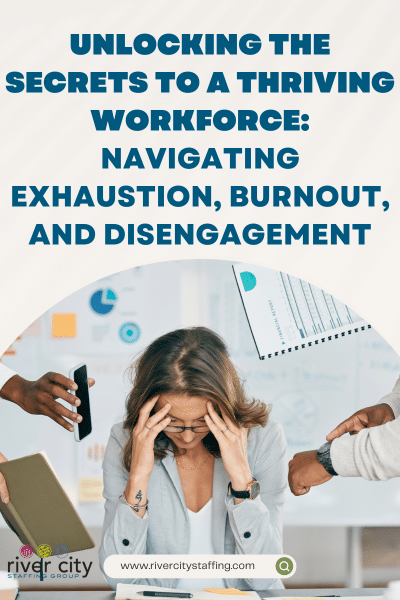In today’s fast-paced world, it’s more important than ever to keep a pulse on the well-being of our teams. After all, research consistently shows that happy workers aren’t just more enjoyable to be around; they’re also better performers and teammates. So, let’s dive deep into understanding the nuances between exhaustion, employee burnout, and disengagement, and explore how we, as part of the staffing industry, can cultivate environments where employees thrive.
The Fine Line Between Exhaustion, Burnout, and Disengagement
Imagine your team returning to work after a well-deserved break. Do they come back recharged and ready to take on challenges, or do they seem to carry the weight of the world on their shoulders? This simple observation can tell you a lot about the health of your workforce.
- Exhaustion is like hitting a temporary low battery – a good break can recharge those energy levels.
- Burnout goes deeper, manifesting as a state of emotional, physical, and mental exhaustion caused by prolonged stress. It’s a warning sign that an employee feels overwhelmed and underappreciated, and a weekend off isn’t enough to fix it.
- Disengagement, on the other hand, is when employees start withdrawing. They’ve moved past burnout to a point where they lack motivation and passion for their work.
Identifying these signs early is crucial for leaders aiming to foster a positive and productive work environment.
Cultivating Happiness and Engagement
As leaders within the staffing industry, we have a unique opportunity to address these issues head-on, not just within our organizations but also as we place talent in businesses that value their well-being. Here are some strategies to help combat burnout and boost engagement:
- Encourage Open Communication: Create a culture where feedback flows freely. Employees should feel comfortable sharing their struggles without fear of retribution.
- Support Work-Life Balance: Encourage your team to disconnect after hours and respect their time off. A well-rested employee is a happy and productive one.
- Manage Workload Effectively: Keep an eye on workloads to ensure they’re realistic. Overburdening employees is a fast track to burnout.
- Recognize and Reward Efforts: Everyone wants to feel appreciated. Simple acknowledgments can go a long way in boosting morale and motivation.
- Offer Opportunities for Growth: Employees should feel like they’re progressing in their careers. Providing training and development opportunities can reignite their passion and commitment.
- Address Organizational Issues: If systemic issues are causing widespread stress, it’s time for a change. Listen to your employees and take action to create a healthier work environment.
Meeting Your Team Where They Are
Remember, every individual is unique. What recharges one person might not work for another. As leaders, our job is to understand these differences and adapt our support accordingly. By doing so, we not only help our employees but also position our businesses for success.
In the staffing industry, we’re in the privileged position of shaping not just our workplaces but those of our clients. Let’s lead by example, showing the world that prioritizing the well-being of our teams is not just good practice—it’s essential for thriving in today’s competitive landscape.
Together, let’s build happier, more engaged, and ultimately more successful workplaces. After all, a happy team is the secret ingredient to unprecedented growth and success. Here’s to creating work environments where everyone feels valued, understood, and energized to contribute their best. Cheers to our collective growth and fulfillment!
